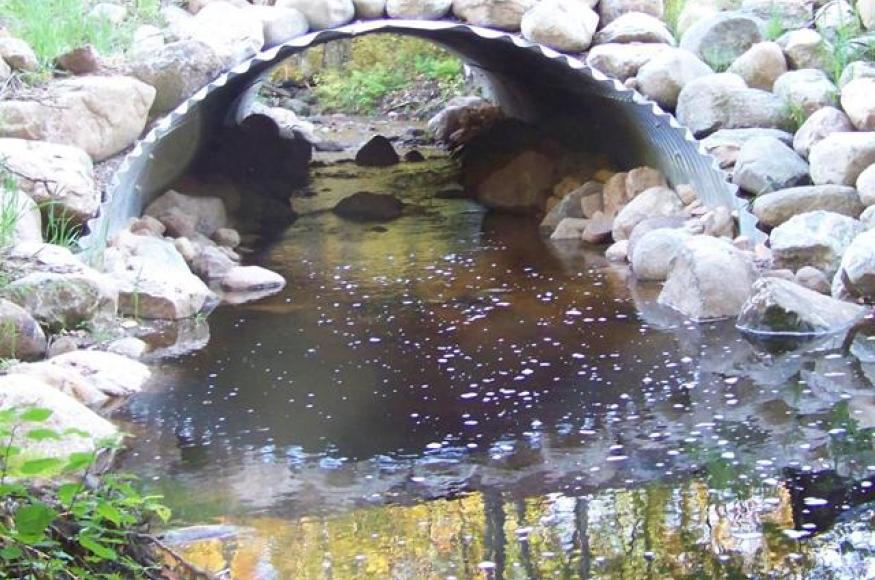Project Area
 The Great Divide District of the Chequamegon-Nicolet National Forest contains Twentymile Creek and the headwaters of the Marengo River. These two watersheds, which provide clean water that flows to Lake Superior, have been identified by the Forest as the highest priority watersheds for restoration activities. Several watershed restoration activities have been identified by the Forest, and this adaptation project was designed to evaluate how these actions could be carried out in a way that increases the resilience of the watersheds, including the waters and adjacent forests, to changing conditions. Several of these watershed restoration activities are being implemented through the USDA Landscape Restoration Partnership (see more below).
The Great Divide District of the Chequamegon-Nicolet National Forest contains Twentymile Creek and the headwaters of the Marengo River. These two watersheds, which provide clean water that flows to Lake Superior, have been identified by the Forest as the highest priority watersheds for restoration activities. Several watershed restoration activities have been identified by the Forest, and this adaptation project was designed to evaluate how these actions could be carried out in a way that increases the resilience of the watersheds, including the waters and adjacent forests, to changing conditions. Several of these watershed restoration activities are being implemented through the USDA Landscape Restoration Partnership (see more below). Management Goals
Twentymile Creek and the headwaters of the Marengo River provide clean water that flows to Lake Superior, and both have been identified by the Chequamegon-Nicolet National Forest as the highest priority watersheds for restoration. This adaptation project was designed to evaluate how several planned restoration actions could be carried out in a way that increases the resilience of the watersheds, including the waters and adjacent forests, to changing conditions. For example, some of the planned watershed restoration projects included:
- replacing undersized and poorly placed culverts with larger, better aligned culverts that will maintain fish passage and restore channel morphology
- planting pine seedlings under the forest canopy on 15 acres of riparian forest to shade streams and eventually act as a source of woody material for the streams
- stabilizing eroding banks to reduce impacts on water quality
Climate Change Impacts
A team of natural resource managers from the Chequamegon-Nicolet National Forest used the Adaptation Workbook to evaluate the potential impacts of climate change on the Chequamegon-Nicolet’s Twentymile Creek and Marengo River watersheds. Some of the most prominent impacts include:
Warmer temperatures and changing precipitation patterns could have a number of effects on these water bodies. More frequent or intense rainfall or changes in spring snow melt could increase run-off and lead to greater risk of erosion and sedimentation.
Warmer water temperatures, more severe rainfall events, or other changes in hydrology could affect habitat for cold-waters species such as brook trout. While both watersheds may be vulnerable, the greater influence of cold groundwater in Twentymile Creek
Increases in storm events may have effects on the forests in the watersheds. More windthrow events could result in younger forests and increase the amount of downed wood in forests and streams.
More frequent or intense flood events could also result in greater damages to infrastructure, such as bridges, culverts, and roads.
Future conditions may be less suitable to important riparian tree species, such as balsam fir, and black and white spruce. Other species, such as white pine, may be less susceptible to decline.
Adaptation Actions
Chequamegon-Nicolet National Forest staff considered their planned restoration actions and considered whether they would contribute to climate change adaptation. In many cases, they were able to identify substantial adaptation benefits for the work they had planned. Some of the adaptation actions that stand out in this project include:
Area/Topic
Approach
Tactics
Twentymile Creek
1.2. Maintain or restore hydrology.
1.3. Maintain or restore riparian areas.
7.2. Maintain and create habitat corridors through reforestation or restoration.
1.3. Maintain or restore riparian areas.
7.2. Maintain and create habitat corridors through reforestation or restoration.
Installing larger culverts will withstand greater stream flows that may occur more frequently in the future, reducing negative impacts from erosion and sedimentation.
Planned harvest activities will diversify the riparian areas. This will reduce the risk of the forest being negatively affected if one or a few species are especially susceptible to climate change-related stressors or declines.
Plant one site with pine seedlings, which are expected to be better-adapted to climate change than many other native tree species. Conifer trees will also help to cool stream water throughout the year.
Headwaters of the Marengo River
Stabilize three eroding banks to reduce the risk of erosion and sedimentation during severe rain or snowmelt.
Riparian areas will be managed to reduce aspen and increase tree species diversity. These ideas will become less suitable for beaver, which could help maintain cold water habitat for native brook trout.
Project Documents
DemoHighlights_CNNF_1-9.pdf
(683.49 KB)


